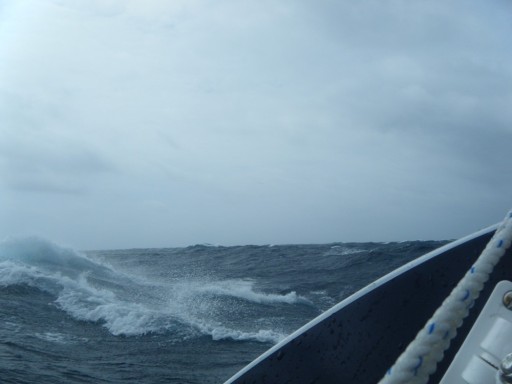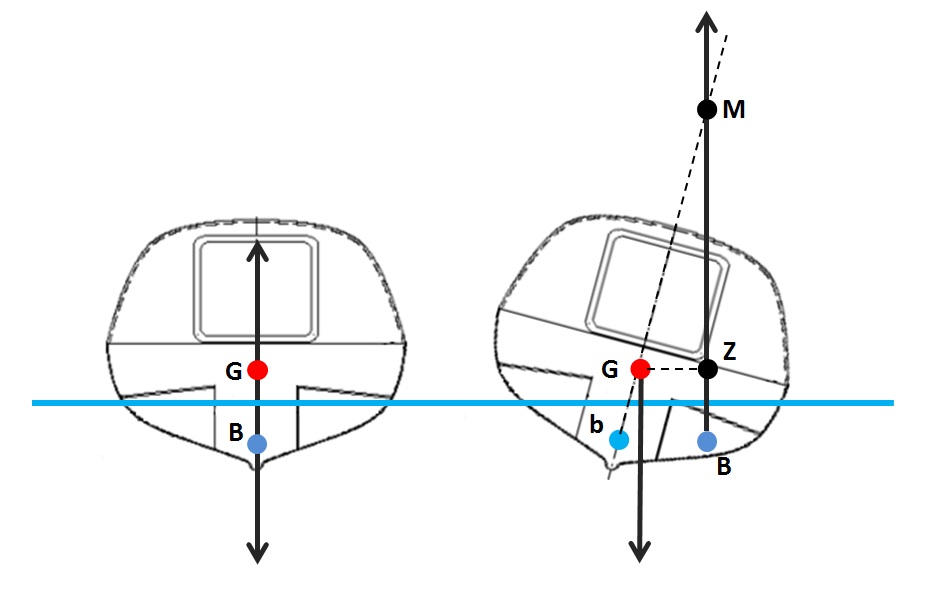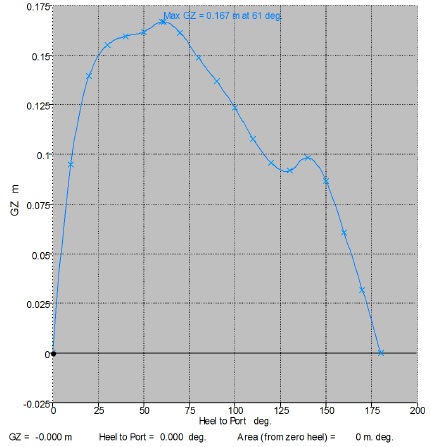You will notice that most of the designs of ocean rowing boats have the same basic layout. The rower(s) sit in the middle of the boat with a cabin at either end. At least one of these cabins is used as the accommodation where the crew sleep and rest. If only one of the cabins is being used as accommodation, then it will be the larger one. A rudder at the stern helps to steer the boat and, in some boats, a center board or dagger board can be lowered into the water mid-way down the boat to help keep the boat stable and / or allow the crew to row at a more acute angle to the wind.
Self-righting and the principles of stability / buoyancy
When operated correctly, most ocean rowing boats (and all of those allowed to participate in the Great Pacific Race) are designed to self-right. This means if they are turned upside down (inverted), they will turn themselves the right way up without the crew having to do anything. The ability of a boat to self-right is a direct result of the boat’s stability. A self-righting boat, when being used correctly, is always more stable the right way up and less stable when inverted. It is this which means that it will try and turn over if inverted.
It may sound obvious but it’s important to note that a more stable boat will be less likely to capsize than an unstable one. It will also self-right more aggressively if it does capsize and overcome some situations which may cause a less stable boat to remain inverted.
Stability is defined as a boat’s ability to return to its previous position. Positive stability is when a boat returns to an upright position and negative stability is when it capsizes. In its most basic form, stability is mostly about two main forces, the downward pull of gravity and the uplifting force of buoyancy. It is the relationship between these two forces, the center of buoyancy and the center of gravity, which define how stable (or not) a boat is.
Static stability
So, how does a hull gain its stability? To understand this, it helps to refer to the drawing above which shows a boat hull at rest and heeled at 15° which demonstrates the principles of ‘form stability’.
G represents the boat’s Centre of Gravity – the point through which the downward forces, due to the boat’s structure and equipment, act.
B is the Centre of Buoyancy – the point through which buoyancy acts.
To all intents and purposes, as long as there is no water in the boat’s lockers or cabins, G’s position is fixed, whatever the angle of heel. (It will change slightly as equipment and crew roll around inside the cabin, but for the moment we’ll assume it’s fixed).
B’s position moves around significantly. This is because the shape of the hull immersed in water alters drastically as the boat heels and trims. This is where we get our form stability. The lower case ‘b’ shows B’s position when the hull was upright. At that time, G and B were in vertical alignment and the hull was in a state of transverse equilibrium (zero heel). Then, something happens to change the position of G. This could be a wave, a gust of wind or a member of the crew moving around. What happens next?
B moves against the force exerted by G creating a ‘couple’, a sort of lever, known as GZ. This forces the boat back upright again. Knowing the length of the lever arm and the weight (mass) of the boat, we can calculate the ‘righting moment’ which is generally expressed in Newton/metres.
Another significant point is ‘M’ – the metacentre. This is at the intersection between the extension of the hull’s centreline and a line drawn vertically upwards from B. The distance between G and M is known as the metacentric height (GM) and – at small angles of heel – is proportional to the boat’s stability.
It’s common practice for naval architects and designers to plot GZ for every heel angle between upright and capsized. It’s usually called a stability or GZ curve and is critically important.
The area contained under the curve above the line indicates the amount of energy available to keep a boat the right way up. The area (if there is one) below the line shows the energy required to right a boat if it capsizes. The larger this area, the less easy it will be to return a boat to the upright position. For self-righting ocean rowing boats, this curve is always positive and so the boat will always try to self-right. This relies on G remaining in the same place throughout the capsize, as when the boat was designed. There are a few things that can affect G and prevent a boat from self-righting when a capsize takes place.
Anything in the boat that can move has the potential to affect the position of G, and thus prevent the boat from self-righting. This can be from something as simple as a loose item inside the cabin, which hits the ceiling during capsize (including any member of crew). The other major element that can drastically alter the position of G is water getting into a cabin or sealed compartment / locker.
Cabins, hatches and ventilators
Without going into all the calculations of stability, center of gravity and buoyancy, it’s difficult to fully explain the details of self-righting. The cabins are critically important when it comes to a boat’s ability to self-right, because they contain a lot of air are therefore buoyant in the water.
However, this turning moment can easily be reduced, if the cabin has some water inside it from an open hatch or leaking ventilator. If you leave your hatch open and capsize, air will leave the cabin, water will come in and the turning moment will be dramatically reduced, potentially meaning that the boat will not self-right. It is for this reason, despite the heat and humidity, that all sensible ocean rowers should choose to keep their hatches shut at all times when rowing, even if the conditions appear far too still for a capsize to be possible. The best way to overcome the desire to have the hatch door open for long periods is to ensure the accommodation cabins have adequate ventilation that can either be sealed in rough conditions or have some sort of valve, to ensure no water gets into the cabin if the boat capsizes. Remember that water in the cabin isn’t just a matter of danger with regards to self-righting (or not) but also to do with comfort. A wet mattress can take weeks to dry out and you risk seriously damaging the essential electrical items kept inside the cabin.
Ballast
Ballast refers to anything that is stored on the boat below the decks. Ballast helps because in the same way that the air in the cabin is lighter than water and tries to float, the ballast is heavier and wants to sink. With these two forces working together, a boat will self-right. The lower down heavy items can be placed, the greater the turning moment they exert on the boat and the larger the area under the GZ curve. Heavy items should also be placed as close as possible to the centre line of the boat to maximize this effect. So, if you have a lot of heavy items on your cabin ceiling, the turning moment will be less and your boat will be less likely to self-right. Also, remember that, unless they are in sealed lockers or tied to the cabin floor, any items that are in the cabin will hit the ceiling if the boat capsizes, thus reducing the turning moment and reducing the chances of your boat self-righting.
Whilst everything on a boat can be considered ballast, it is the denser and heavier items which should be most closely monitored. Life-raft, batteries, emergency water supplies and food should all be stored as low down and as close to the centre line as possible. This is why, in the race rules, there are definitions about where some items should be stored. As items get consumed (e.g. food and maybe emergency water supplies), it may become necessary to replace them with something of similar weight to ensure the stability of the boat is not compromised. Generally, this is done by filling empty emergency water containers with sea water. Additional ballast water can also be added during periods of rough weather when capsize is more likely and stability is more of a concern.
Wind turbines, sun awnings etc.
As we’ve already hinted, anything that is above the waterline during a boat’s normal operation has the potential to slow down or stop a self-righting boat turning the right way up. Some of these items we shouldn’t remove from a boat (such as VHF aerials or Active radar enhancers) because the boat is at greater risk with these items removed. However, there are some other items that significantly reduce a boat’s ability to self-right and as such are banned under the race rules. The higher up an item is, the more impact it will have on the turning moment of the boat; moreover, the more any item catches the water, the slower that turning movement will be, potentially preventing a boat from righting. It is for these reasons that wind turbines, which are heavy and have to be placed as high as possible in order to be effective, are banned under race rules. Sun awnings are also banned and should not be used as their large surface area increases the chance of capsize when they are hit by waves. Also, they slow down the boat’s turning moment when capsized, by effectively turning into a water pouch (as used by life-rafts to increase their stability) and making the capsized boat more stable upside down.
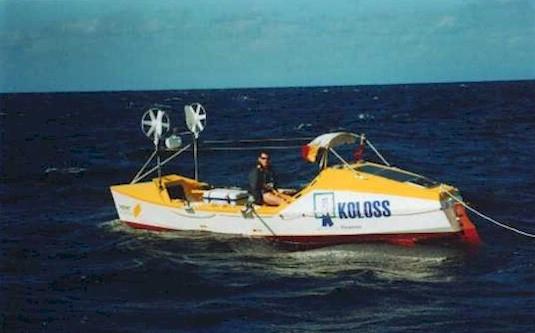
Other items that may cause problems are satellite communication domes. These are relatively large, heavy and need a clear view of the sky in order to operate correctly. The boat has been designed to self-right with a certain amount of ballast stored below decks and not more than a certain amount above decks. By mounting anything onto the top of a cabin, this design becomes altered and therefore calculations and tests should be repeated to ensure that the boat will still self-right if capsized.
Broaching
All boats will suffer from loss of stability when on the face of a wave. If the waves are short and steep (especially common nearer the coast), the situation becomes worse. When the boat heels significantly, the boat tips towards the trough of the wave: this can induce deep rolling motions and even cause a boat to capsize. A beam sea (when the waves are at 90 degrees to the direction in which the boat is pointing) is the most likely time when a boat will capsize. There are some times when broaching (being side onto the waves) is required (for example: to row in a certain direction) but the risk of capsize is always higher in this situation.
Some designs and set-ups of boat perform better than others when in wavy conditions, giving the boat a predisposition to broaching or pointing in the same direction as the waves / wind. It is the combination of both of these factors and more which affect which direction a boat will sit when in waves and wind. However, there is no one factor which determines how a boat will lie when in certain conditions: it is a combination of different considerations.
Wind – A boat is blown by the wind. All other things being equal, the larger the area of the boat being blown by the wind (i.e. the larger the cabin), the greater force exerted by the wind. This is one reason why boats with a larger stern cabin may broach. In this situation, the wind blows a larger stern cabin more than the smaller bow cabin, and so the boat may try to turn around to point into the wind.
Rudder – The rudder anchors the stern of the boat where it is. Because it provides much more resistance than the smooth hull at the bow of the boat, the stern of the boat will move sideways less through the water than the bow of the boat, if the same amount of force is exerted on both the bow and the stern.
Weight distribution – By moving heavier items of equipment and ballast water towards the stern of the boat, you are increasing the force required to move the stern of the boat the same distance (and also reducing the amount of force required to move the bow).
Daggerboard – A daggerboard or centreboard is a retractable device which is similar in appearance to a rudder, but without any means of attaching it to the stern of the boat. Generally, a daggerboard will slot into a casing through the hull of the boat near the bow and protrude into the sea underneath. They are used when the crew of a boat actually want to row side on to the waves, as it will increase the force required to push the bow sideways. This is particularly useful if you want or need to be able to make progress at an acute angle to the prevailing conditions of wind and waves. They can also help a boat track its course as it goes down a wave. (see more about daggerboards below)
Rower – When rowing, you have a significant impact on how the boat will sit in wavy and windy conditions. If your boat goes off course slightly, you can pull harder on one side or manually adjust the rudder to steer the boat slightly to overcome the effect of the conditions.
Using a centerboard or daggerboard
Working in the same way that a wind turbine can slow down the self-righting ability of a boat when inverted, a centerboard or dagger board can help reduce the chance of a boat capsizing in the first place. A centerboard provides a large flat area that any potentially capsizing force will have to push through the water in order to push the boat over and capsize it, thus reducing your chances of capsizing in aggressive conditions. However, a centreboard will add additional resistance to your boat, so you may not want to leave it in all the time. A centreboard also has a secondary function of helping to stop the bow of the boat being pushed round by the wind (if you need to row across it). Finally if you’re taking your boat out of the water (perhaps after a training row) and putting it onto a trailer, don’t forget that if you do have a centreboard deployed. The boat won’t get too far onto the trailer if you forget.
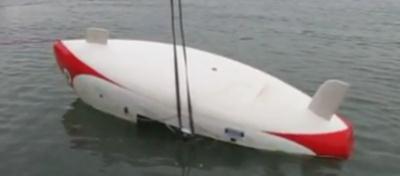
What this all means
You might hear a story of a boat capsizing and not self-righting. This is always because a hatch, ventilator or other opening has let water into what should be an airtight cabin or because not enough ballast has been placed and/or secured low down in the boat. Make sure the next story of this happening isn’t your story!
- Shut all hatches unless you’re going through them or are in the process of accessing what is inside.
- Make sure that any ballast water you drink is replaced immediately (with sea water, if freshwater is not available)
- Make sure that any heavy items are placed as close to the centre line and as low down in the boat as possible.
- Test your boat in its lightest possible racing configuration (i.e. without any food on board, etc.) to test that it will still self-right, even if you’ve eaten all your food.
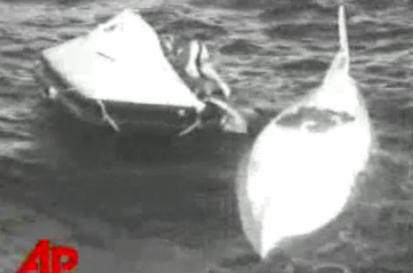
Further Reading
Ship stability for Masters and Mates by Bryan Barrass and Capt D R Derrett – http://seaworm.narod.ru/2/Stab1.pdf
